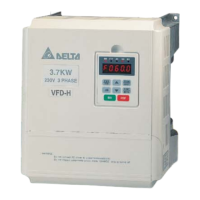Chapter 7 Optional AccessoriesMS300
58
7-4 AC / DC Reactor
AC Input Reactor
Installing an AC reactor on the input side of an AC motor drive can increase line impedance, improve the
power factor, reduce input current, increase system capacity, and reduce interference generated from
the motor drive. It also reduces momentary voltage surges or abnormal current spikes from the mains
power, further protecting the drive. For example, when the main power capacity is higher than 500 kVA,
or when using a phase-compensation capacitor, momentary voltage and current spikes may damage the
AC motor drive’s internal circuit. An AC reactor on the input side of the AC motor drive protects it by
suppressing surges.
Install an AC input reactor in series between the main power and the three input phases R S T, as shown
in the figure below:
Figure 7-4
AC Output Reactor
When using drives in long wiring output application, ground fault (GFF), over-current (OC) and motor
over-voltage (OV) often occur. GFF and OC cause errors due to the drive's self-protective mechanism;
over-voltage damages motor insulation.
The excessive length of the output wires makes the grounded stray capacitance too large, increase the
three-phase output common mode current, and the reflected wave of the long wires makes the motor dv
/ dt and the motor terminal voltage too high. Thus, installing a reactor on the drive’s output side can
increases the high-frequency impedance to reduce the dv / dt and terminal voltage to protect the motor.
Install an AC output reactor in series between the three output phases U V W and the motor, as shown in
the figure below:
Figure 7-5

